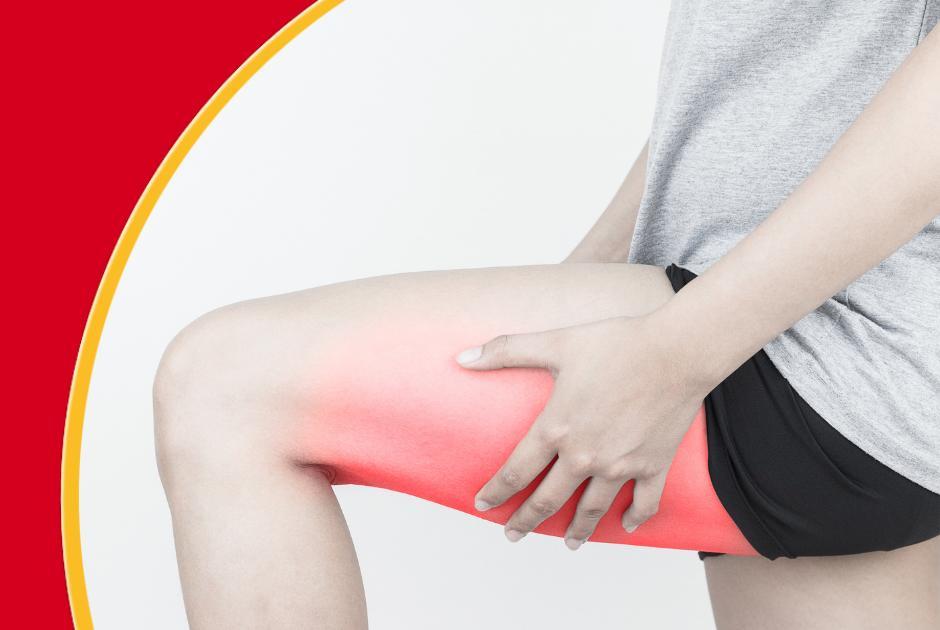Hamstring Injury? Here's What To Do
Posted on 21st December 2022
What’s a hamstring strain?
A hamstring injury can occur if any of the tendons or muscles are stretched beyond their limit. The most common cause of pain in the posterior thigh is a hamstring strain from an acute injury. Pain can also develop following an injury that has failed to heal properly.
A hamstring strain or pull is a tear to the muscle fibres in one of the three muscles, the semitendinosus, semimembranosus or biceps femoris, which make up the hamstring group at the back of the upper thigh. They run from the lower part of the pelvis and insert into the back of the shin bone and when contracting they powerfully bend the knee and extend the hip backwards.
Causes of hamstring strains
Acute or sudden hamstring strains usually happen in two ways; either sprinting or stretching.
Hamstring strains often occur during sudden, explosive movements, such as sprinting, lunging or jumping. During sprinting, the hamstring muscles work extremely hard to decelerate the shin bone just before the foot strikes the ground, and it is at this point, the hamstring is most likely to tear. Sprint-related hamstring injuries most commonly occur lower down the thigh (in the biceps femoris muscle where the muscle joins the tendon) and often feel worse but recover more quickly.
Stretch-related injuries usually occur higher at the back of the thigh in the tendon of the semimembranosus muscle and may take longer to heel as the injury is more likely to the tendon where blood flow is lower.
Others causes can include:
Other causes can include:
cramping of the hamstrings
muscle contusion
origin tendonitis
referred pain
Symptoms
Symptoms usually consist of a sudden sharp pain at the back of the thigh. They are graded 1, 2 or 3 depending on how bad they are.
Grade 1: The patient may have tightness in the back of the thigh and is aware of some discomfort but will be able to walk normally.
Grade 2: The patient will most likely be walking with a limp and have some swelling, bruising and pain. Sudden twinges of pain during activity will occur that can be reproduced when pressing on the hamstring or trying to bend the knee against resistance.
Grade 3: This is the most severe injury involving a tear to half or all of the muscle. The patient may need crutches to walk and feel severe muscle pain and weakness. Swelling will happen immediately and bruising will usually appear within 24 hours.
Pulled hamstrings are very common, and can reoccur, and we suggest that someone should see a therapist as soon as possible if they suspect a grade 2 or 3 injury.
Prevention and treatment
We recommend our patients do the following to prevent and treat hamstring injuries:
warm up properly with dynamic exercises and cool down with static stretches
don’t push too hard too soon when building up training levels
stretch your quadriceps and lower back
in acute stages (24-72 hours) apply PRICE. Protection, rest, ice, compression, elevation
when pain allows you can start stretching and strengthening, please ask your therapist for advice
taping may help, the therapist will advise
massage will help reduce scar tissue and re-align muscle fibres facilitating full recovery
Three exercises to help
Bent Knee Hamstring Stretch - place your leg onto a chair or low platform. Keep your knee bent and lean forward over your thigh. Gently try and straighten your leg a tiny amount and you should feel a stretch into the middle of your hamstrings.
Alternate Heel Kicks - standing, kick the heel towards the bottom of one leg, go back to your start position, and repeat with the other leg. Heel kicks are useful for warming up the hamstring muscle group (located at the back of the thigh).
Hamstring Curl with Band - tie an exercise band around your ankle, and attach the other end to a fixed object (e.g. such as around the leg of a table). Lie face down. Bend your knee creating resistance in the band. This is a strengthening exercise for the hamstring muscle group
If you’re considering training to be a massage therapist, give us a call or email to find out more about our courses.
Share this post:

